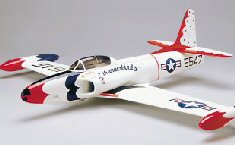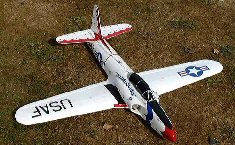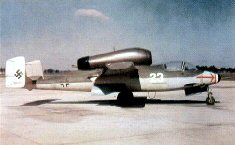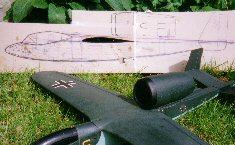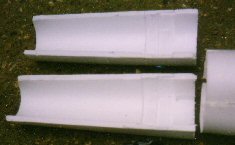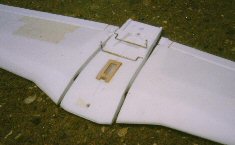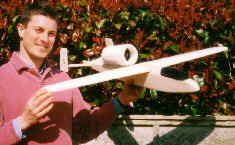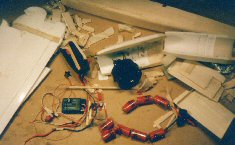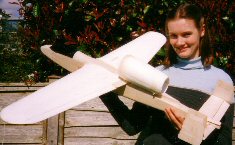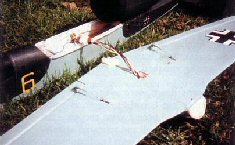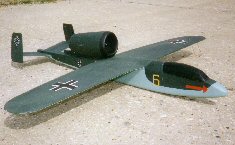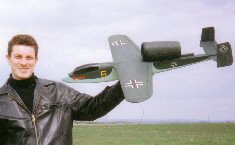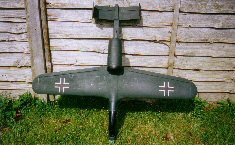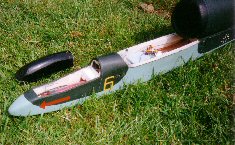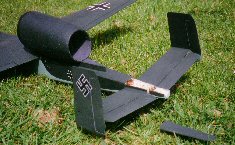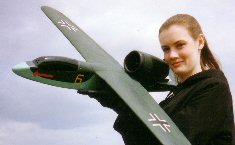|
|||
|
|
|
||
| View Shopping Cart |
| Home |
| Guides Available |
| About the Author |
| FAQs |
| Testimonials |
| Articles |
| Contact Andrew |
| Terms & Conditions |
| Mailing List |
| Links |
 |
 |
More high quality
information absolutely free with every
Gibbs Guides newsletter. Sign
up now!
Heinkel He162
Salamander:
How a Kyosho T-33 was recycled
Article by Andrew Gibbs
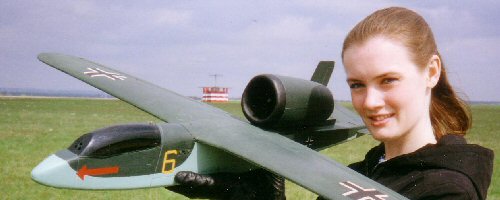
This article was written way back in 2001. It’s still relevant to electric modelling today, so here it is, in a slightly revised format.
Introduction
I was one of the many modellers who enjoyed Kyosho’s
semi scale Lockheed T-33. I admired the company for having
brought to the market such a bold and easy introduction
to elctric ducted fan (EDF) flying. I was impressed with
the model in many ways – it was quick to build,
inexpensive, good looking, easily hand launched and well
mannered in the air. A great combination of properties
and the model was deservedly very successful.
However, the one thing it most definitely did not have was a scorching performance. I flew mine about a dozen times and on the recommended seven nicad cells my example had little more than minimum power to maintain flight. On eight, things improved somewhat but not enough to maintain my interest in continuing to fly the model.
| Kyosho's T-33 was a good looking model (click small images to enlarge). | Another of the many T-33 models produced by Kyosho (click small images to enlarge). |
Analysis of Kyosho’s
T-33 design
Examination of the T-33 showed that some elements of its
design were excellent and others, in contrast, seemed
to be rather poor. For example, the wing, judging from
the model’s airborne manners, appeared to be of
excellent aerodynamic design. It was also a very light
and beautifully made structure. The fan unit also seemed
to be well designed and the brushed 480 motor seemed powerful,
especially since it was capable of emptying a fully charged
pack of 1,700mAh nicads in 3½ minutes.
On the minus side, the long ducting was caused a considerable loss of thrust due to poor design. Also, the airframe, while generally clean had a number of details causing high drag. One example of this was that the wing and tail were both joined at acute angles to the fuselage.
T-33 thrust measurements
Initially, I planned to develop the model in the quest
for more performance. On the T-33’s box Kyosho claim
their fan unit produces 14oz (400g) of thrust, presumably
on the recommended 7 cells.
My thrust measuring rig, which I believed to be quite accurate, showed that the installed thrust of my model showed an initial peak of 11oz (312g) and averaged 9.7oz (277g) over the first minute, using a freshly charged 7 cell pack. On 8 cells the initial thrust was 12oz (340g) and averaged 11.5oz (325g) over the first minute. Here are the figures in table form:
T-33 data |
7 cells |
8 cells |
Weight |
38.2oz (1,083g) |
40.2oz (1,139g) |
Average thrust |
9.17oz (277g) |
11.28oz (325g) |
T/W ratio |
25.5% |
28.5% |
Wing area (inc root) |
300sq inches (19.3sq dm) |
|
Wing loading |
18.4 oz/sq ft (56g/sq dm) 19.7oz/sq ft (59g/sq dm) |
|
The reason for the model’s lack of performance was now clear– a T/W ratio of 25% is considered the normal absolute bare minimum for flight (Note: today with lipo and brushless power the norm, this ratio is considered completely inadequate).
Design of the new
model
I then decided that it would be more interesting to design
a new model using the best of the T-33’s components,
i.e. the fan, motor and beautifully made wing. I realised
that if I could mate these parts with a new, lower drag
fuselage and some efficient ducting then the resulting
model would be significantly livelier than the T-33.
My design criteria for the new model were:
1. It should still be able to be hand
launched.
2. It should use at least some of theT-33’s components
3. It should be reasonably simple and easy to modify if
initially unsuccessful
4. If possible, it should resemble a real aeroplane.
After considering several possible design ideas, I decided to turn my model into a semi-scale representation of a Heinkel He-162 Salamander.
| The He-162 was a remarkable aeroplane. | The design sketch from which the model was built. |
The full-size He-162
Towards the end of WW2 the German aircraft industry produced
a number of remarkable designs. The He-162 was one of
these and was designed and built in late 1944, in the
astonishingly short period of a little over 2 months.
This design seemed to have a suitable configuration upon which to base a model – its jet engine was located in a short straight-through duct located on top of a slim fuselage – ideal! The design did have very small, short wings, but these could be enlarged for the model.
It was made largely of wood, a non-strategic material. It weighed up to 5,940lbs and was powered by a BMW turbojet providing 1,764lbs static thrust. This gave the machine a T/W ratio of only 30% and consequently it suffered from a relatively poor rate of climb, although it was fast with a top speed of 560mph at 20,000ft. Very few of the machines saw active service and of this small number it seems many were lost due to accidents and in-flight break ups. I was hoping for a better record of success, but the project was not to be without a few problems.
I made some sketches and then I drew out a full-sized side view of the new fuselage on an old bit of cardboard box (no expense spared in my workshop). This looked quite attractive (the design, not the box) so I decided to build it there and then from the sketch. This was is in stark contrast to my usual process of drawing up a proper plan and thinking the whole thing through before a knife gets anywhere near balsa.
The wing and tail are both set at +1 degree incidence. I made the tail moment slightly longer than on the donor machine. The thrust line is at +3 degrees to compensate for the high thrust line of the “piggyback” fan position.
I checked that the CG would end up where I wanted it by placing a balsa plank over the side view on the bench. A pencil was located under the plank at the required CG and the plank was balanced with small weights. I then added all the required components and balsa sheets to simulate the weight of the airframe and its contents along the length of the plank. This showed that moving the battery would cater for any likely CG adjustments necessary. No way was this aeroplane going to be carrying any ballast!
Wing loading
I wanted to reduce the span of the T-33 wing a little
to get more of the visual feel of the Heinkel and also
to increase the model’s roll rate. This decision
would of course reduce the wing area and consequently
increase the wing loading. I felt the model would probably
tolerate this provided I could get the fan to deliver
substantially more thrust, and if the airframe’s
drag was minimised.
Weight target
After much weighing of the components at my disposal,
I set an ambitious target weight of 39oz (1,100g) for
the model. Even if the weight went to 42oz (1,200g) I
felt I should still have a flyable model. All wood would
be weighed before use, and cyano used for much of the
construction.
Construction - Fuselage
First I set about building a fuselage from the side view
that I had sketched. This is a simple balsa box, using
3/32” (2.5mm) sides with doublers of the same thickness.
I used a generous (but light) triangular section along
the corners so that the shape would be nicely rounded,
for low drag, when sanded. A fillet is fitted to the outside
of the wing seat to reduce the drag of the wing-fuselage
junction.
The canopy is the T-33 item, suitably cut down and stuck to a removable balsa frame so that it becomes the battery hatch. I fitted a sprung locking pin to the rear edge of the frame. Three holes are drilled in the flat front portion of the canopy to admit cooling air.
Motor, Fan and Pod
The motor pod is made from the rear of the T-33’s
fuselage. I cut through the fuselage 1/2in (15mm) aft
of the original motor mounting slot, and discarded the
last 3in (80mm) of this portion. This gave me a duct about
7in (180mm) long, into which I cut a new motor mounting
slot using a Dremel-type tool further aft. An additional
1in (30mm) of soft balsa was added to the front of this
tube and shaped to form an elliptical intake.
The overall length of the completed motor pod was 8.25in (210mm). Power was fed to the motor through a pair of steel blades that had come from a windscreen wiper. These were located one behind the other, forming a thin, low drag strut. The fan blades were carefully cleaned up and the fan checked for balance. Also the stators were slightly re-profiled to try and reduce their drag.
| The duct for the Salamander was cut from the rear portion of the T33’s fuselage. | The T-33's wing has had its center section removed. |
Tail plane and Fins
These were simply cut from 1/4in (5mm) medium balsa and
shaped to a streamline section. The tailplane spans 12.6in
(320mm) overall with a root chord measuring 3.7in (95mm).
Each half was blocked up 1in (25mm) to set the dihedral.
Anti-warp strips were inserted in the 5in (125mm) high
fins.
Wings
Having finished the fuselage, I still had some doubts
about going for a reduced wing area. I put these aside
and sawed the wing in to 2 panels, which when placed together
again gave a straight leading edge, a distinctive visual
characteristic of the He-162. Each new panel weighed only
2.25oz (64g), and the material I had removed weighed 1.4oz
(40g) including the aileron torque rods.
The removed centre section was 3.7in (105mm) wide at the leading edge. I consoled myself that the lost area was less than it appeared since the fuselage was quite narrow in comparison to the T-33 and I had reduced both weight and frontal area. In any case, there was no going back now!!
Each wing was sanded overall and carefully trimmed so that the roots mated accurately with zero dihedral – the top surface of the wings is flat. The panels were then joined with epoxy and joint was reinforced with 1/16in (1.5mm) balsa, also epoxied. A single mini servo and new lightweight linkages were installed to operate the ailerons.
Preparation for flight
The controls and equipment were then installed and the
aircraft readied for its first flight. The speed controller
was located under the wing, behind the receiver and in
front of the elevator servo.
I had decided not to paint the machine until I was satisfied it flew well. I range checked it at half power and found that the receiver that I originally planned to use gave a range of only 18 meters with the Tx aerial retracted. However, range improved to 75 yards (70m) with a different receiver. I also covered it in cooking foil to give it further protection from its proximity to the speed controller. I used the rest of the foil in the preparation of a tasty roast dinner that I put it in to the oven for my supper! In my excitement to fly the model, I forgot to photograph it or put it on my TMR. The ready to fly weight had come out at 39oz (1,100g) approx with an 8-cell pack.
First flight –
April 1st 2001
I range checked the machine again at the field at half
power: 75 yards (70m) again with aerial down. The equipment
inside the machine was the same as I had used in the T-33
and I felt confident that all would be well.
The model was hand launched into a light southeasterly wind. It was slightly sluggish for a second or two and then climbed away strongly. A little trimming of the controls saw it flying smoothly around, and I felt confident to try loops and rolls. All who saw it were very impressed with its performance. It was easily able to maintain height on half power and could loop from level flight. A couple of times the motor slowed momentarily before regaining full power, but other than that, no problems were evident.
I continued to enjoy myself but then suddenly, at a distance of only about 50yd (48m) away while down elevator selected, the Salamander stopped responding to the controls. I attempted to pull up and shut the motor off but without success. I could only watch as my beautiful aeroplane developed an almost vertical dive in to the concrete runway from some considerable height. The entire airframe was wrecked – wings broken in two, fuselage all broken up, tail snapped in three places, flight battery and the aileron servo was destroyed. Strangely, the nylon M4 wing bolt was undamaged. I felt thoroughly dejected.
| I was confident the model would fly well, but nevertheless it was tested without paint, just in case. A wise precaution as it turned out . | Ouch! The model ended up completely wrecked after the first flight. |
Back home, I found that things had gone from bad to worse – my roast supper had burnt! However, all was not lost. In some ways the day had been a great success – the aircraft had flown very well and appeared aerodynamically sound. And I had not invested any time in painting it!
After consuming the edible portions of
my supper I went to my workshop to survey the wreckage
in search of clues. I could not definitely determine the
cause of the crash, but, being brutally honest with myself,
the cause was probably something for which I was somehow
responsible. After much thought and discussion, the following
theories were formed as reasons for the disaster:
1. The speed controller BEC function had failed.
2. Loss of signal due to the transmitter aerial pointing
directly at the model (this would give a very weak signal
in the direction of the model)
3. The elevator linkage had become disconnected in flight.
4. The battery pack had moved during the negative g manoeuvre
5. Radio interference
6. Poor equipment installation, particularly the speed
controller’s position, sited as it was, amongst
the rest of the gear.
I also discovered that the balsa in the vicinity of the blade supplying motor power had become burnt, which I could not account for.
| The rebuild took a long time. Here's the repaired airframe, before painting. |
The servos and receiver
aerial are routed through the wing. For convenience, a single 9-way computer 'D' connector was used to connect the fuselage-to-wing wiring. |
Rebuilding
In spite of the extensive damage, I decided to rebuild
the model. Amazingly, this proved to be a much quicker
affair than its initial construction. The wing was epoxied
back together and a spar inserted locally across the break
to help carry flight loads. I also applied 2 thicknesses
of tissue with dilute PVA across the centre third of the
wing to help reinforce the joint.
At this point I decided to replace the single aileron servo with a pair, installed one in each wing. This would give the ailerons the ability to act as flaps - this might be useful since the model’s wing loading was climbing still further with the weight of all the repairs!
The wrecked fuselage was rebuilt, this time with a better battery retention system (Velcro and small polystyrene locating blocks) and an all-new elevator linkage. I installed a dual conversion receiver with a new crystal, again wrapped in foil. A new elevator servo was fitted, relocated to just behind the receiver. The speed controller was relocated to a position directly under the motor. This kept it well away from any other radio equipment. The motor was fitted with additional suppression, which now comprised 3 capacitors, plus a diode across the motor terminals. The BEC function of the speed controller was disabled and an 110mAh hydride receiver battery installed behind the cockpit canopy.
The receiver aerial had originally been routed through the fuselage. It was now re-routed out through the wing to keep it away from the motor and speed controller – and its weight also helped balance the weight of the epoxy repairs in the other wing! I wired both wing servos and the aerial through a de-shelled 9-way computer D plug, taking great care to ensure that the effective aerial length was not altered. This meant that all the electrical connections could conveniently be made with just one plugging in operation.
At this point, I felt that I had now done everything I could to minimise the chance of a repeat of the disaster. Since the model had flown well (apart from the landing!), it was now time to paint it.
Finishing
The first stage of finishing was to apply a dope and lightweight
tissue covering to the fuselage. This added only 0.4oz
(12g). The foam motor pod also had tissue applied, but
using dilute PVA to avoid melting the foam. Once dried
out, this was lightly sanded and a covering of dope was
applied. Several coats of dope were also applied to the
tissued area of the wing. The whole model was then painted
with Tamiya acrylic colour, which added another 0.35oz
(10g).
Markings were also painted on, using enamel. Lastly, I added black panel lines, highlighted with white along what would be raised edges, as described by Chris Golds in a magazine article. I was very pleased with the model’s finished appearance. It certainly looked a lot better than at the conclusion of its first flight!
| Painting really brought the model to life. | After three weeks of repairs, the model was ready for testing once again. |
Testing!
I was very disappointed to discover that the weight of
the model had crept up to 42.5oz (1,204g), and really
pleased to find that the TMR revealed that the initial
static thrust was 16.9oz (480g), and averaged 15.7oz (445g)
over the first minute. This gave an average T/W ratio
of 37%.
Also the mystery of the hot blade had been solved; the steel was getting very hot due to the current flowing. Realising that the steel blade was a material with an electrical high resistance, I replaced the it with thick copper wire and re-tested it – no more heat and even more thrust – over 17.6oz (500g) initially!!! This result showed that Kyosho’s claim of 14oz (400g) thrust for their fan unit was justified, if it was efficiently installed.
Finally I checked every possible detail of the whole model and completed all necessary measurements and photographs.
Flying once again
- 22 April
The model was tested again on a windy 22 April. Prior
to flying, I decided that I would not point the transmitter
aerial at the model, even if it was close by, and that
I would immediately land at any sign of a malfunction,
however slight.
In spite of the weight increase, the performance was at least as good as before. The model seemed relatively unaffected by the wind, probably due to its relatively high wing loading. Climb rate and level flight speed were good. It was able to loop from level flight and it had a good rate of roll. However, the flaps, although they gave no trim change when deployed did not seem very effective. This was probably on account of their modest size.
By comparison with the T-33, I estimated the top speed in level flight was about 50% greater, and the speed in a dive about double. The flight time was 6 1/2 minutes, about half of which was ambling around at low power for photos. There were no control problems, and the flight was a complete success. I could not have been more pleased!
| The Salamander is seen here in planform. The wings could have been made shorter. | A replacement canopy was made from a block of foam, skinned with balsa along the bottom edge and covered in brown paper before painting. |
The model was taken to a number of model flying events over the next few years, including one in Holland where it crashed, probably due to being 'shot down' by another transmitter on the same frequency. The model was such a good flier that I rebuilt it again. the model was later upgraded to brushless motor and a lipo battery, giving a significant performance jump. The model continued to give me pleasure until it was crashed again, this time in France. At this point, I'd decided I'd spent enough time mending it, and so it was scrapped.
| The tail area of the model. The fins are fixed; there is no rudder control. | This project eventually had a successful conclusion, but it was not without its problems. |
Conclusion
This was an enjoyable and satisfying project and my aim
of producing a capable model using the parts from the
T-33 was satisfied. The project taught me a lot about
EDF and probably even more about persistence! Grateful
thanks are due to Chris Golds for sharing his knowledge
both through his writings and by telephone.
| Salamander technical data | ||
| Span | 1,055mm | 41.5in (T33:45.5in) |
| Length | 940mm | 37in |
| Flying weight (8x1700SCR nicad cells) |
1,204g |
2lb 11oz ( 43 oz) |
| Wing Area | 17.3dm | 1.85 sq ft (266 sq in) |
| Wing Loading | 70g/dm | 23.3 oz/sq ft (T33: 19.7) |
| Battery | 8-cell NiCd, then 3S 2,500mAh LiPo | |
| Motor | Brushed 480, later brushless 400 | |
| Thrust (8x nicad) | 480g (T33: 320g) | |
| T/W ratio | 39.8% (T33: 28%) | |
| Power Loading (max power) | 195 W/kg | 88 W/lb |
| Tail span, average chord and area | span 12.6in, 3.75in 47sqin = 17% of wing area | |
| Control functions | Ailerons, elevator, throttle & flaps. | |
Note: All the power system themes touched
on here such as power loading and much more are explained
clearly in the 3-part series on Electric Power Systems
